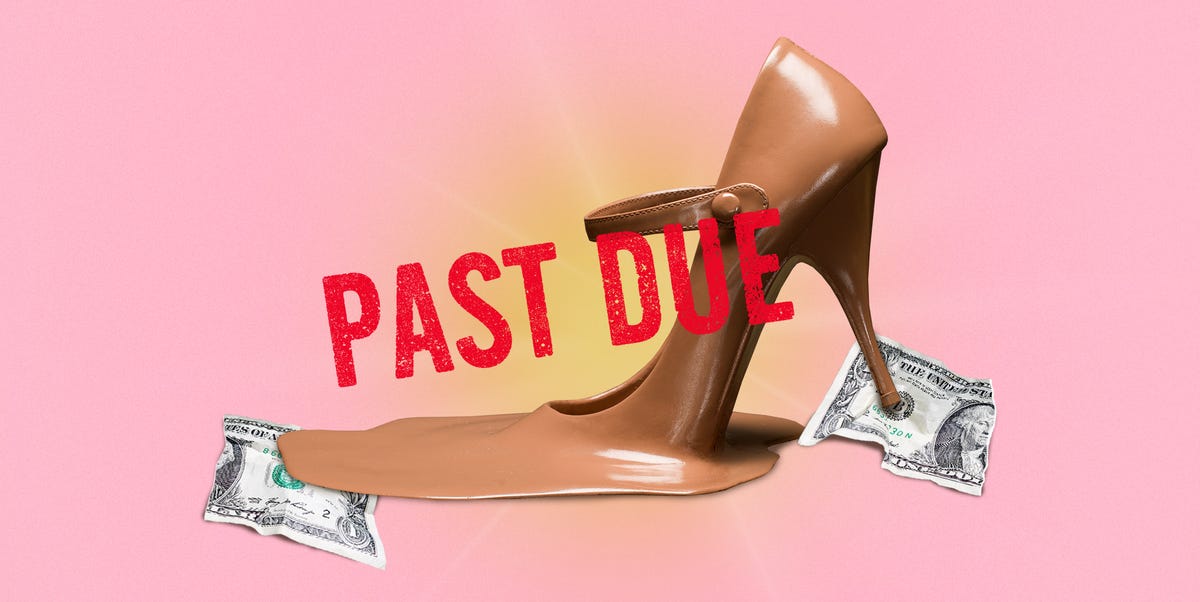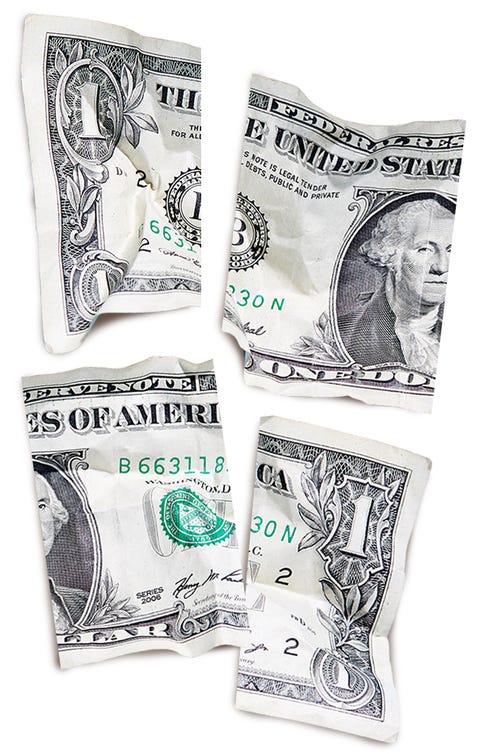“Besties, I don’t know who needs to hear this, but: just because you’re paying for it on Afterpay, doesn’t mean you’re not paying for it,” TikToker Maddie White admonishes to her 2.5 million followers, looking directly into the camera. “Four hundred dollars is still $400, and if you couldn’t afford to pay for it all at once, you probably can’t afford it at all.”
The caption for the video: “Afterpay is the sole reason none of us 20 something b—ches have any savings.” This piece of content, which the 26-year-old L.A.-based influencer filmed last year (and has since amassed over 300,000 views, 52,000-plus likes, and 500 or so comments), hits a strikingly different chord from her usual fare of fun fashion hauls and outfit try-ons. But the message, she felt, was absolutely necessary: a lesson about the repercussions of “buy now, pay later” (BNPL) services that she personally had to learn the hard way.
“I was broke for my entire early ‘20s, so when I wanted to buy clothes, I would find it on a site that had Afterpay or Klarna,” White, who first encountered BNPL on Boohoo and Nasty Gal after it was advertised to her as an option to pay in installments rather than the full amount, tells ELLE.com. “I couldn’t afford something, but I could afford that small payment. That’s how you get into a sticky situation, because when you have several purchases at once, all of a sudden, you have payments that are hundreds or thousands of dollars. It definitely allowed me to make more irresponsible purchases.”
For the uninitiated, BNPL is essentially a payment plan—a type of installment loan—that splits the total sum of your purchase into equal payments (usually, a payment every two weeks, spanning six weeks), oftentimes without incurring any interest. The big ones are Affirm, Afterpay, Klarna, PayPal, Sezzle, and Zip. And what makes using BNPL so irresistible and more appealing than, say, a credit card is that virtually anyone (with a bank account, that is) can take advantage of it, regardless of whether you have bad credit—or any credit at all. So, it’s easy to see why Gen Z, a demographic that may not have access to credit cards, but, for the first time in their lives, have spending power, are a natural target.
“Gen Z comprises some of the leading adopters of BNPL apps, but it’s not always super clear how the platforms work—and they often differ from one another,” says Cassandra Napoli, senior strategist at trend forecasting company WGSN Insight, who notes there are two ways in which someone might use BNPL: 1) to purchase necessities, and 2) to buy non-essential items that help them maintain social status and clout, despite not having the means to pay for them. “Young and impressionable consumers might not be aware of the financial commitment they’re getting into when they first leverage these services.”
Adds Napoli: “Despite rising inflation, BNPL platforms could help consumers access trending pieces seen on TikTok, but there may be a knowledge gap at play here. They may simply see the ability to access a high-ticket item or multiple viral pieces without needing to pay for them right now…and they may not understand the long-term impact of failing to pay.”
Already, that pattern of missing payments—and consequently, falling into debt—is starting to emerge. According to a survey conducted by Piplsay, 43 percent of Gen Zers have missed at least one payment in 2021. A study done by Qualtrics on behalf of Credit Karma found that more than half of Gen Z and millennial respondents have missed at least one payment, compared with Gen X (22 percent) and Boomers (10 percent). Scott Galloway, a marketing professor at NYU, called BNPL “the equivalent of the subprime mortgage crisis” for millennials and Gen Z in a Pivot podcast episode.
Having unfettered access to inventory has a powerful psychological pull. “You’re buying something, but you’re not paying for it right away, and that gets people into trouble, because it’s delaying the inevitable,” says psychologist Susan Weiss. “You end up thinking you have more money than you do because you really owe this money—and you use that money to buy other things, and it can get out of control. It’s a slippery slope, and a really painful lesson for young people to learn.”
White, for one, isn’t surprised at all that many are falling victim to the BNPL trap—because she was “absolutely that girl,” missing payments herself after buying multiple items and losing track of how much she owed. But she’s quick to say she never racked up thousands of dollars in debt—she managed to change her spending habits, which she credits to getting older, having more disposable income (she no longer uses BNPL for that reason), and being more thoughtful with her purchases. But she undoubtedly understands why the shopping model has such a firm grip on Gen Z, especially with the increasingly truncated trend cycles on TikTok.
“When I was 18, I was definitely buying new outfits for every weekend, and that was before TikTok—a lot of it is peer pressure,” explains White, who uses her 19-year-old sister as an example for how Gen Z shops. “It’s cool to have new things instead of wearing the same looks over and over again. And TikTok has made it 10 times worse, because micro trends last about a month. [My sister] tells me that all of the girls in her sorority are buying new clothes on Shein every single week: They order it on Thursday, pay for next-day shipping, it arrives in time for them to wear to a sorority or frat party on Saturday night, and then they throw it away.”
Fast fashion is by no means a new concept, but ultra-fast and inexpensive fashion brands, like Shein (the biggest in the market, clocking $15.7 billion in sales in 2021) with its two-week turnaround time, Boohoo, and Fashion Nova have only exacerbated the problem, turning TikTok into a breeding ground for this kind of must-buy-now behavior, and making Gen Z more susceptible to BNPL.
“TikTok functions as a library of viral aesthetics and micro trends, with new ones popping up seemingly every day; just like other visual platforms, it has ignited FOMO and attached social status to these trends, influencing young and impressionable consumers to want to buy into them, ultimately creating an endless appetite for newness and driving consumerism,” says Napoli, citing a 2018 WGSN report titled The Gen Z Equation, which analyzed the two polar-opposite sides of the generation. There’s “Gen Me,” those driven by trends (and the group most likely to get swept up by viral TikTok fashion trends) and “Gen We,” the group that’s forcing brands to rethink strategies around issues like sustainability. “Of course, buying into trends costs money, and with Gen Z strapped for cash and facing economic uncertainties and rising inflation, it makes sense that they’d turn to BNPL apps to help fund their trend ambitions.”
It doesn’t help, either, that there are TikTok videos dedicated to glorifying the use of BNPL (some are paid ads, too, with Gen Z influencers selling BNPL services to other Gen Zers). In fact, the hashtag #BuyNowPayLater yields nearly 45 million views on the social networking service—an endless scroll of videos that show users bragging about how little they’ve paid for a purchase.
“The moment when you hit check out, you feel like you’re only spending $10 instead of $50,” White says. “But I don’t fundamentally believe that there’s anything wrong with [BNPL], because it’s driving sales for all the companies that are using them, and they’re making products more accessible to the younger Gen Z market, who live paycheck to paycheck. It’s more palatable to pay a portion of something as opposed to all at once.”
That’s precisely why Rebecca Minkoff, the designer behind her namesake line of ready-to-wear and accessories, chose to partner with Swedish fintech company Klarna (her brand is one of Klarna’s 400,000 global retail partners). “We want to offer our customers the easiest and smoothest way to purchase something,” she says. “For a lot of our customers, this is their luxury purchase, so it’s kind of a no-brainer for those who can meet the minimum payments and not feel the burden in one paycheck cycle. If it had been available when I was young, I would have used it in a heartbeat.”
The problem is that BNPL’s convenience makes it extremely easy to overspend. And there’s no stopping someone from hopping from one BNPL platform to another, because unlike the credit card industry, the BNPL industry still lacks oversight. In response to Gen Z falling behind on payments, a spokesperson at Klarna says safeguards are in place to prevent that from happening, including conducting eligibility checks, reassessing lending criteria, providing spending limits, sending reminder notifications before an upcoming payment, and restricting the use of services until any missed payments are fulfilled. (On average, an outstanding balance on Klarna is about $70, which is significantly lower compared with $5,525, the average outstanding credit card balance in the U.S.)
“We believe people should pay with the money they have first, but when it makes sense to use credit, our interest-free products offer a fairer and more sustainable alternative,” says a Klarna spokesperson, who asked to remain anonymous. “Our products are not built on encouraging people to borrow as much as possible at the highest possible rate like credit card providers. Financial wellness is built into our products and everything we do from our short-term repayment plans to budgeting tools in the app to help encourage healthy money habits.”
Even so, it doesn’t tackle the brewing crisis at hand. And while it’s easy to point fingers at BNPL companies, the glaring issue is the lack of financial literacy in the U.S. Napoli says it’s worth noting that some content creators—like White—are addressing the red flags that come with misusing BNPL services, and by doing so, they’re “democratizing education to the masses, which is essential to encourage responsible consumer behavior.” She continues, “The reality is these platforms can pose a long-term risk to those who can’t make their payments. There needs to be warnings communicated to audiences that tell them that alongside the positives, there are also dangers and downsides to BNPL.”
White believes a financial literacy course in high school should be mandatory. “It’s basically impossible to get a credit card without already having established credit,” she says. “Nobody teaches you how to establish good credit and how to stay on top of it—and it makes it really hard on the younger generation.” Only time will tell whether that will help Gen Z resist the temptation of TikTok-fueled fashion trends with the click of a finger.

